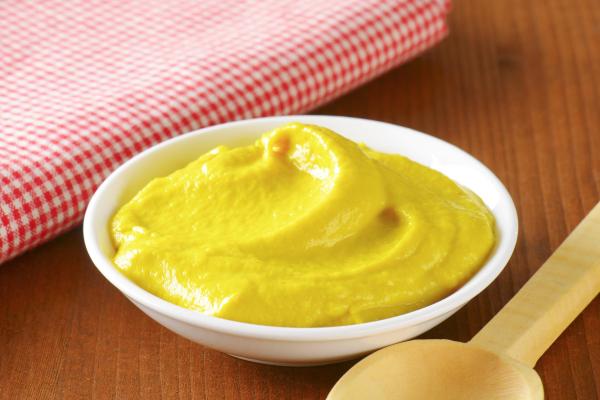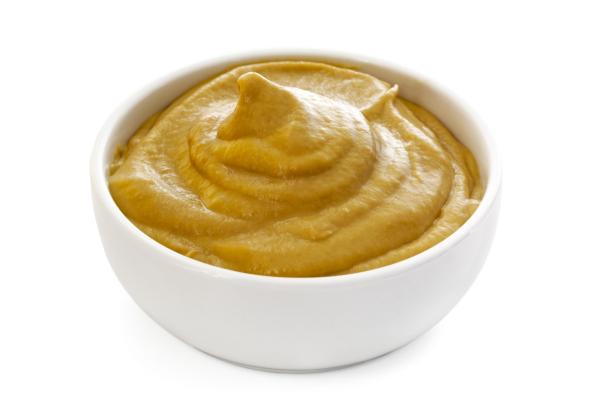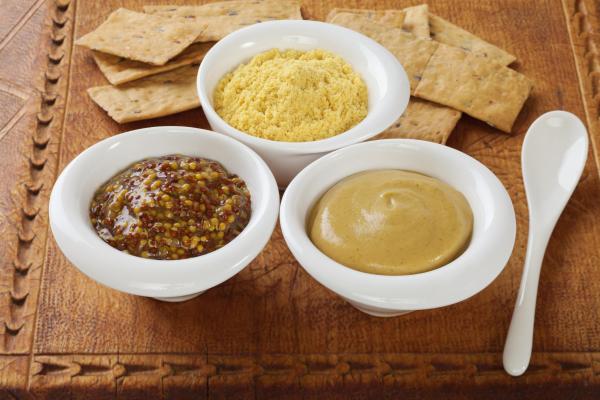Different Types of Mustard and Their Uses


If you are a mustard connoisseur, you know that asking for mustard in a restaurant is a gamble. When you want some wholegrain for your steak and American yellow comes along, it can make you question your life choices. All mustard comes from a mustard plant, but not all mustards are the same. This is partly because not all mustard plants are the same, but it also is dependent on other factors. Not only is the amount of mustard seed important, but how it is introduced to the sauce can be a significant factor.
At oneHOWTO, we explain the different types of mustard and their uses. While we suggest the best food for each mustard type, it is important to know that the mustard you choose for your dish is the one you prefer. We only recommend you try each mustard type so you can see what your palate prefers.
What is mustard?
As referenced in the introduction, mustard is made from mustard plants. Some people may wonder whether it is technically a sauce or a condiment, but those people have too much time on their hands. A condiment is a preparation that adds spice or extra flavor to a dish. They can come in sauce form, as with mustard and ketchup. They can also be in crystal or powdered form, such as salt and pepper.
Mustard is one of the most popular condiments around the world, but the type of mustard you are likely to get will depend on the food culture you are experiencing. For example, yellow mustard is common in American barbeque and Dijon is the moutarde au choix of many Parisian bistros.
While we will look into greater detail at the different types of mustard you can buy, but all mustard falls under three main categories. These categories of mustard are dependent on the type of mustard plant from which they are derived:
- White mustard: from the plant Sinapis alba.
- Brown mustard: from the plant Brassica juncea, also known as Chinese mustard, Indian mustard or leaf mustard.
- Black mustard: from the plant Brassica nigra.
It is from these three species of mustard plant that mustard seeds are harvested. It is these seeds which provide the spicy and tangy flavor common to all mustards. How it is prepared differs greatly, but we provide the most common types of mustard and their uses in the sections below.
American yellow mustard
American yellow mustard is the workhorse of all mustard types. Although it was once only a staple in the United States, it is now one of the most common mustards across the globe. This is partly thanks to its use in food such as the Big Mac, meaning it is used in the most far reaching restaurant in the world.
American yellow mustard is indeed a yellow mustard, and how. It can sometimes be described as nuclear yellow, such is its uncommon brightness in the condiment rack. This coloration is thanks to very finely ground yellow mustard seed and the addition of turmeric. Preparation of American yellow mustard consists of mixing these two ingredients with vinegar and water.
Although the color of American mustard is an intense yellow, it is perhaps the mildest of all mustard sauces. It has a sweet and tangy flavor, with les piquancy than other mustard types. This is partly thanks to the addition of sugar, something which can be added in larger or smaller quantities according to the brand.
Partly due to its common use in American diners, American yellow mustard is commonly used on the following dishes:
- Hamburgers
- Hot dogs
- Fries
- Fast food in general

Bavarian sweet mustard
America is not the only country known for a particular type of mustard. Germany is also famed for having various types, although it is perhaps best known for its brown mustard. Bavarian sweet mustard is a type of brown mustard typical of Bavaria. It is a mustard that has a much higher amount of sugar than almost any other type of mustard. It can have as much as a whopping 40 g of sugar per 100 g of mustard.
Sweet brown mustard is the one that always appears in Oktoberfest promotions. Due to its high sugar content, it is one of the most easy to eat mustards, but it is also the reason you should use it sparingly. It can be a great addition to salad dressings and other sauces, as long as it is not designed to be particularly healthy.
Some common dishes which use Bavarian sweet mustard include:
- Bratwurst
- Pig knuckle
- Ham sandwiches
- Sweet salad dressings

English yellow mustard
American yellow mustard is derived from English mustard, which is still made under the Colman's brand. In its beginnings, this brand only sold a powdered version that you can still buy to make a homemade mustard. This requires you adding water to a powder and beating it until homogenous. This helps to make it shelf stable for longer and is also a fun tradition for many families.
English yellow mustard is especially hot. When eating English mustard, there is a tingling sensation which is often felt up through the nose. This is due to its low acid content and its preparation involving a mixture of both brown and yellow seeds. This misture gives it an interesting color which has the darkness of the brown mustard, but also a neon tint of the yellow.
Although it is not very sweet in flavor, English mustard does have sugar (about 13 grams per 100 grams). Although it can be used in various dishes across the world, it is particularly known for being used in English cuisine. In particular, it is a must-have for a good Sunday roast. Some dishes which use English mustard include:
- Roast lamb
- Roast chicken
- Steak
- Potato salad
If you want to see how these dishes can be made at home, check out our recipe for homemade potato salad with mustard.
Dijon mustard
It is the preferred mustard in France. Jean Naigeon was the first person to prepare this mustard in 1856, in the French town of Dijon. This is where this type of mustard earned its named. He replaced the vinegar with an acid must of green grapes. It is not currently made to this tradition method. Instead, most of this type of mustard is made with white wine or spirit vinegar.
Dijon mustard is the spiciest type of mustard you can find. For this reason, it is often used in other sauces or as flavoring to other preparations. It is ideal to make vinaigrettes, stews or even to add to mayonnaise. Dijon and mayonnaise mixed together is sometimes known as Dijonnaise, with the mayo cutting through the spice and acidity of the mustard.
Dijon has been incorporated into various traditional French dishes. It is such a popular condiment in its home country that we can often find Dijon mustard already on the table next to the salt and pepper. Some of the common dishes which call for Dijon mustard include:
- Roast beef
- Sauerkraut and sausages (choucroute garnie)
- Foie gras
- Charcuterie board with cheese and meat
Before you use this mustard on your steak, maybe you want to check our guide to ensure your beef isn't spoiled.
Whole-grain mustard
Although popular in France, the Netherlands and even the USA, no one cuisine can lay claim to whole-grain mustard. Also known as granary mustard, this is a type of mustard that uses a much coarser ground for the mustard seeds. Sometimes this can mean the grains are completely intact, but usually there will be some bruising to the seed to release the flavor. When we eat it, we can feel the seeds pop and release their piquant flavor.
Whole-grain mustard is prepared with brown and black seeds. Although this should make the sauce spicier, the intact nature of the seeds means it is actually milder than you may think. Its taste is actually quite vinegar forward since this is used in the rest of the preparation. It is an acidic mustard, but with a broad flavor.
Whole-grain mustard is often selected for its texture as much as its flavor. It is commonly used in the following dishes:
- Fillet steak
- Vinaigrette (and other salad dressings)
- Sandwiches
- Roast potatoes

French mustard
Despite its name, this is not actually a mustard from France. Instead, it is an English concoction which was used as a compliment to English mustard. Instead of the powerful spice of the English mustard, this one uses brown mustard seeds to create a milder and more tangy mustard which can be used more liberally.
Although not as common as it once was, it is a popular mustard for traditional French and English cuisines (which have more in common than either traditions might like to admit). This means French mustard is popular for:
- Steak
- Veal cutlets
- Pork chops
- Sausage sandwiches
We cannot confuse French mustard with ‘French's mustard’. The latter is a popular American brand of yellow mustard which is widely sold in the US.
Other types of mustard
Although we have covered the main different types of mustard and their uses, there are some other options you might want to know about. They include:
- Fruit mustard: this is a mustard preparation which uses the addition of fruit such as dark berries to create a naturally sweet and tangy mustard.
- Spirit mustards: these are types of mustards which use alcoholic spirits to give it a different take. Whisky is used in Scottish spirit mustards, but it can also be made with cognac, wine or even Jack Daniels.
- ‘Deli-style’ spicy brown mustard: a brown mustard seed-based mustard which is usually a little hotter, a little sweeter and a little darker than American mustard.
- Hot mustard: mustard prepared with various types of hot sauce or even horse radish to give it an extra spicy kick.
Now you know all the different kinds of mustard and their uses, you might want to start pairing them with other ingredients to make your favorite dishes. See our guide to vinegars for salads to learn more.
If you want to read similar articles to Different Types of Mustard and Their Uses, we recommend you visit our Food & drink category.







